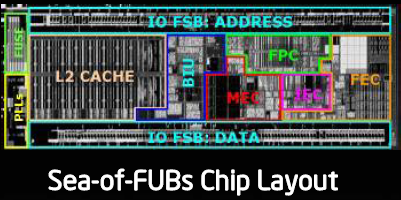ISSCC 2008: Details on Intel Silverthorne

At this year's ISSCC 2008 (International Solid State Circuits Conference), details of Intel's new 45nm Silverthorne will emerge. Intel CTO Justin Rattner held a press briefing last Wednesday to preview some of the highlights of this week's highly technical ISSCC conference in San Francisco.

Intel Silverthorne is a brand new Intel x86 processor for the Menlow platform developed from the ground up for low-cost and ultra-low power applications. This includes UMPC (Ultra Mobile PCs), MID (Mobile Internet Devices), set-top applications, some embedded applications, and eventually for smart phone applications though this initial generation may not be suitable yet. Its small 25mm^2 die size on a 45nm process allows 2500 chips to fit on a single 300mm diameter wafer allows for extremely economic production.
From Rattner's press conference last week, we know that Silverthorne will launches in the first half of 2008 but Rattner will not give a yes on a Q1 launch in response to one of the questions. The first Silverthorne dies were publicly shown in April of 2007 in IDF China so it's quite possible that we're looking at a second quarter launch. Rattner also explained that Silverthorne was a dual-issue in-order pipeline architecture with HT (Hyper-threading) and that this was better than hyper-threading in out-of-order architecture. I later got verification via email that the HT type was SMT (Simultaneous multithreading) and not SoEMT (Switch-On-Event Multithreading).
The slides shown by Rattner indicated that Silverthorne had a power consumption below 1W and up to 2W and that it was "10x lower power than ULV Dothan". The Dothan was the second generation Pentium M product and ULV parts had a TDP (Thermal Design Power) of 5W. I later got clarification via email that Silverthorne processors can have TDPs as low as 0.6W with lower clock speeds and higher clocked parts will have a 2 watt TDP. I spoke with analyst David Kanter of Real World Technologies and he explained that 0.6W which doesn't factor in chipset power consumption might be too high for smart phone applications. However, its immediate successor in the Moorestown platform which may launch late 2008 may solve that problem with its SoC (System on Chip) design.
Update 3:10PM - There are quite a few inaccurate reports out there on Silverthorne's power consumption. They have reported the power consumption of Silverthorne as 0.6W to 2W which is not correct. 0.6W is actually a TDP rating which describes PEAK power consumption. Actual idle power consumption can dip down to 0.01W for some models and 0.1W for other models. Intel is not saying too much more right now but it is reasonable to assume that this extremely low power state is designed to maximize battery life in Smart Phones. Keeping a continuous Skype or SIP application presence in a UMPC or MID device to receive calls is now a possibility.
The 2 GHz variant of the Silverthorne processor will operate at 1 volt and it will have performance equivalent to a first generation "Banias" Pentium M notebook processors circa 2003. Rattner confirmed this was for single-threaded performance on a broad range of applications. This would seem to imply that with multithreaded applications, the performance would be even higher than Banias which lacks Hyper-Threading.
Here are some additional quotes pulled from Rattner's slides:
- Deep power down C6
- Optimized register-file and cache 6T bits cells
- CMOS mode on quad-pumped FSB IO
- Split IO power supply
Here are some additional email responses:
- 0.6W to 2W measured TDP power on real world applications – over the lifetime of the processor/architecture
- Can achieve 2GHz core frequencies at 1.0V
- Will support features such as Digital Media Boost (SSE3), Intel Virtualization technology, Intel 64 Architecture support, HT